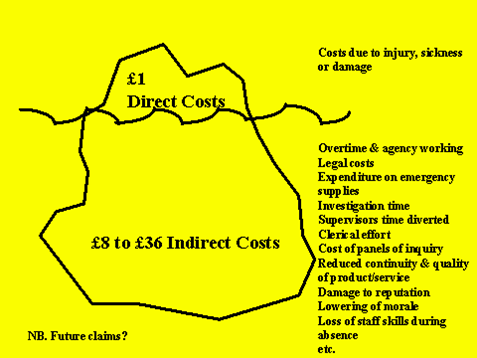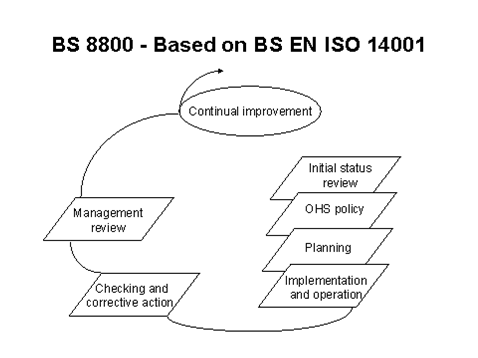
Image taken from http://www.safecode.co.uk/Power%20Point%20Presentations/management/sld004.htm
|
Quality Management and Safety Engineering (BSc) - MST 326 Occupational Safety and Health. |
Before you commence any work, you should undertake a risk analysis and, if chemicals are involved, a COSHH analysis.
PowerPoint presentation: 368 KB
Contents
Health & Safety costs facing organizations include but are not limited to:
The indirect costs of injury, sickness or damage far outweigh the indirect costs as illustrated in the National Health Service SafeCode diagram:

Image taken from http://www.safecode.co.uk/Power%20Point%20Presentations/management/sld004.htm
Occupational health and safety management systems
In respect of management systems:

Image taken from http://www.safecode.co.uk/Power%20Point%20Presentations/management/sld017.htm
OHSAS 18001 (Occupational Health and Safety Assessment Series)
Certification against OHSAS is aimed at the way a company has
all relevant risks resulting from normal operations and abnormal situations.
There is growing demand for a management system based standard for Occupational Health & Safety, either as a stand alone management system or (preferably) integrated with either the ISO 14001 and/or ISO 9001 management systems. In 2003, it was expected that an ISO-based accreditation scheme would emerge within the next two years, but this has proved too controversial and there are now no plans to develop an international standard.
Traditionally occupational health and safety management reacted to work related incidents. OHSAS 18001 plans for the control of work related risks. The Occupational Health and Safety Assessment Series OHSAS 18001 is structured in six sections:
and defined by three key standards:
The benefits of Registration include:
URLs for OHSAS 18001 (checked as live on 26 August 2004):
Control of Substances Hazardous to Health Regulations 1999
What are hazardous substances?
Health effects are the different ways you can become ill:
COSHH does cover, for example:
The presence (or not) of a warning label will indicate whether COSHH is relevant. COSHH does not cover the following, although specific laws do cover these items:
Seven Steps to COSHH
Before undertaking any activity, do consider:
Chemicals (Hazard Information and Packaging for Supply) regulations (CHIP)
Implementation of the European Commission Directive 2001/59/EC of 6 August
2001 (adapting to technical progress for Council Directive 67/548/EEC) relating
to the
classification, packaging and labelling of dangerous substances. The
regulations require the suppliers of such chemicals to:
In respect of MSDS, the School of Chemistry at University of Bristol states "MSDS are documents describing the known hazards associated with a material, indicating safe handling procedures and recommending responses to accidents and thus are invaluable sources of safety information. They are prepared by the Chemical Suppliers and by UK law must be sent to you if you buy a chemical (CHIP) but can be requested even if you are only thinking of buying. If you already have the chemical but the MSDS is lost or the material is so old that none came with it, most manufacturers are happy to fax a relevant MSDS on request. ... If you order a chemical, you are strongly advised to read the MSDS that comes with it and to file it away in a safe place for future reference".
Restriction of Hazardous Substances (RoHS)
EC Directive 2002/95/EC places restrictions on the use of certain hazardous substances in electrical and electronic equipment. The legislation affects manufacturers, sellers, distributors and recylers of electrical and electronic equipment containing lead, mercury, cadmium, hexavalent chromium, polybrominated biphenyls or polybrominated diphenyl ethers. This Directive covers the same scope as the Directive on waste electrical and electronic equipment (WEEE) except for medical devices and monitoring and control instruments. It also applies to electric light bulbs and light fittings in households.
Registration, Evaluation, Authorisation and Restriction of Chemicals (REACH)
This new European Commission Regulation is intended to
REACH passes responsibility for the management of the risks from chemicals to the industry and requires the provision of appropriate safety information which should be passed down the chain of production.
URLs for COSHH (checked as live on 10 February 2007):
URLs for CHIP (checked as live on 10 February 2007):
- CHIP - protection by information, HSE.
- CHIP3 (Chemicals (Hazard Information and Packaging for Supply) Regulations) 2002, University of Bristol.
- Material Safety Data Sheets (MSDS), University of Bristol.
- Technical note, HSE.
- The Idiot's Guide to CHIP, HSE.
URLs for RoHS (checked as live on 10 February 2007):
- EC Directive 2002/95/EC on the restriction of the use of certain hazardous substances in electrical and electronic equipment, 27 January 2003.
- The Restriction of Hazardous Substances in Electrical and Electronic Equipment (ROHS) Directive (2002/95/EC), Environment Agency.
- RoHS Reference Center, Electronic Design.
- RoHS simplified, Dionics plc.
- Understandng RoHS, Shimadzu - 2006.
URLs for REACH (checked as live on 10 February 2007):
- Registration, Evaluation, Authorisation and Restriction of Chemicals (REACH), EC Regulation 1907/2006, 18 December 2006.
- REACH (EUROPA Environment)
- REACH (EUROPA Enterprise and Industry)
- REACH in brief (European Commission)
- Registration, Evaluation, Authorisation of Chemicals (REACH) (DTI).
- REACH Implementation Timeline, Department for Environment, Food and Rural Affairs, February 2007.
URLs for health and safety assessment (checked as live on 10 February 2007):